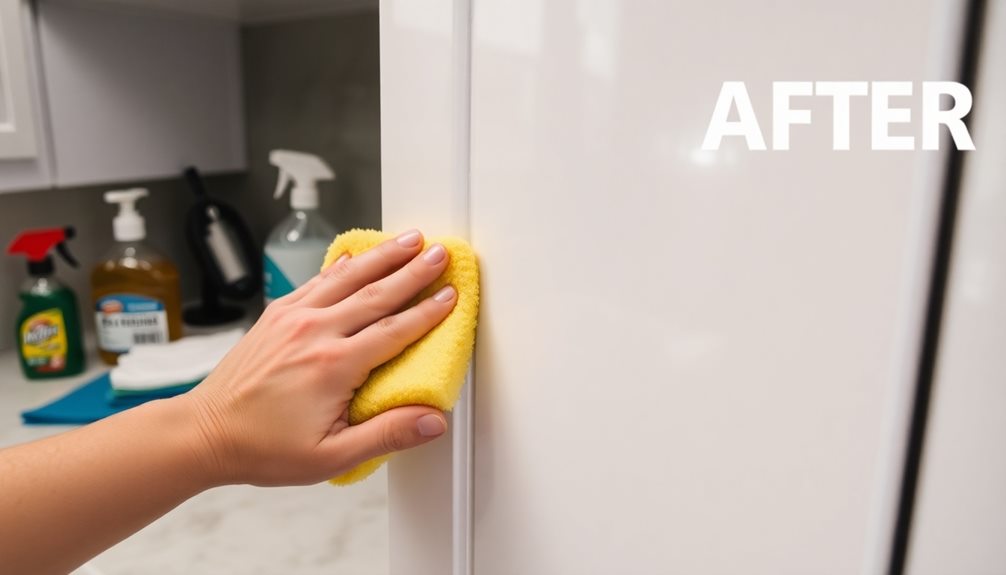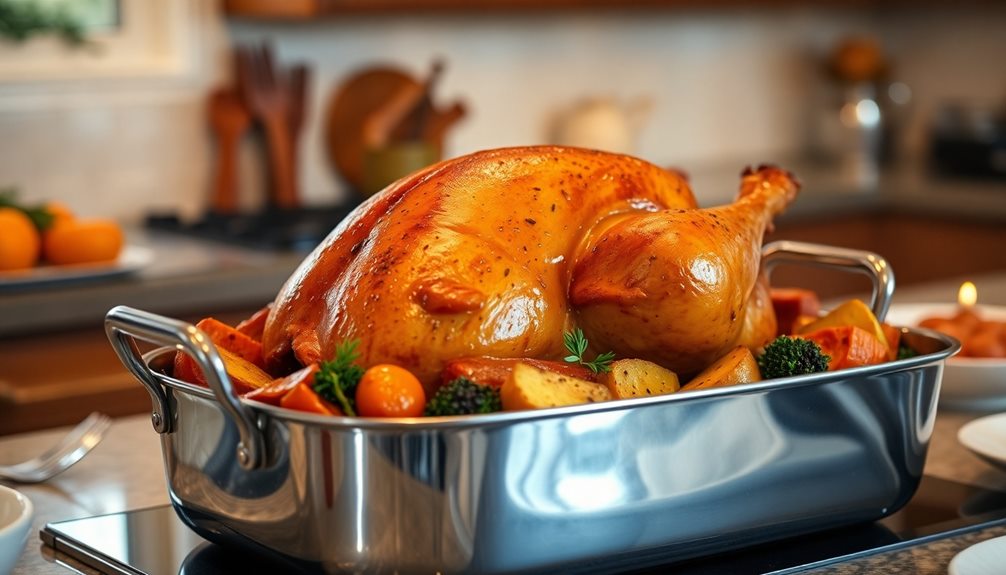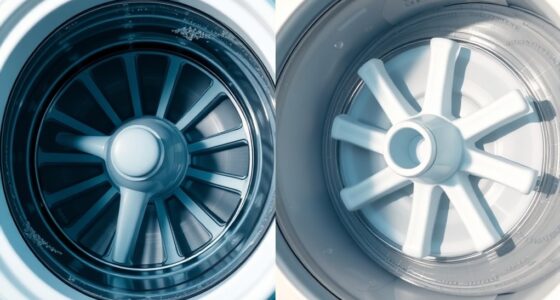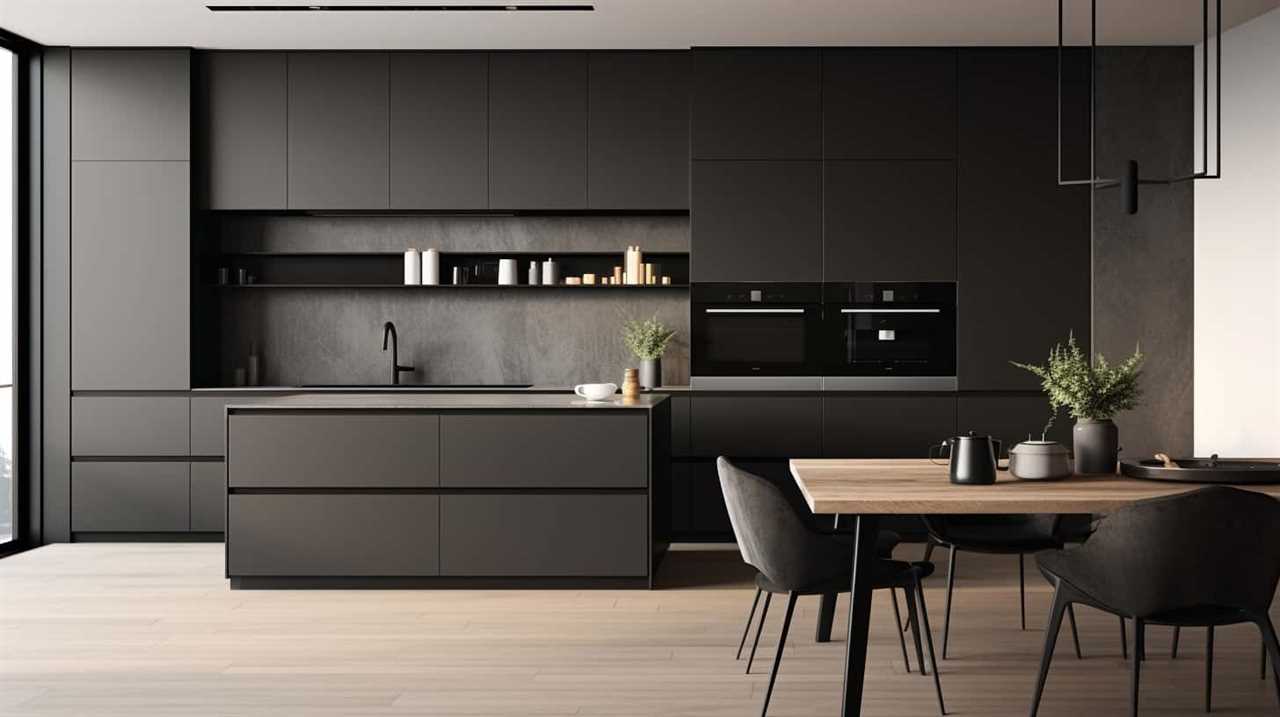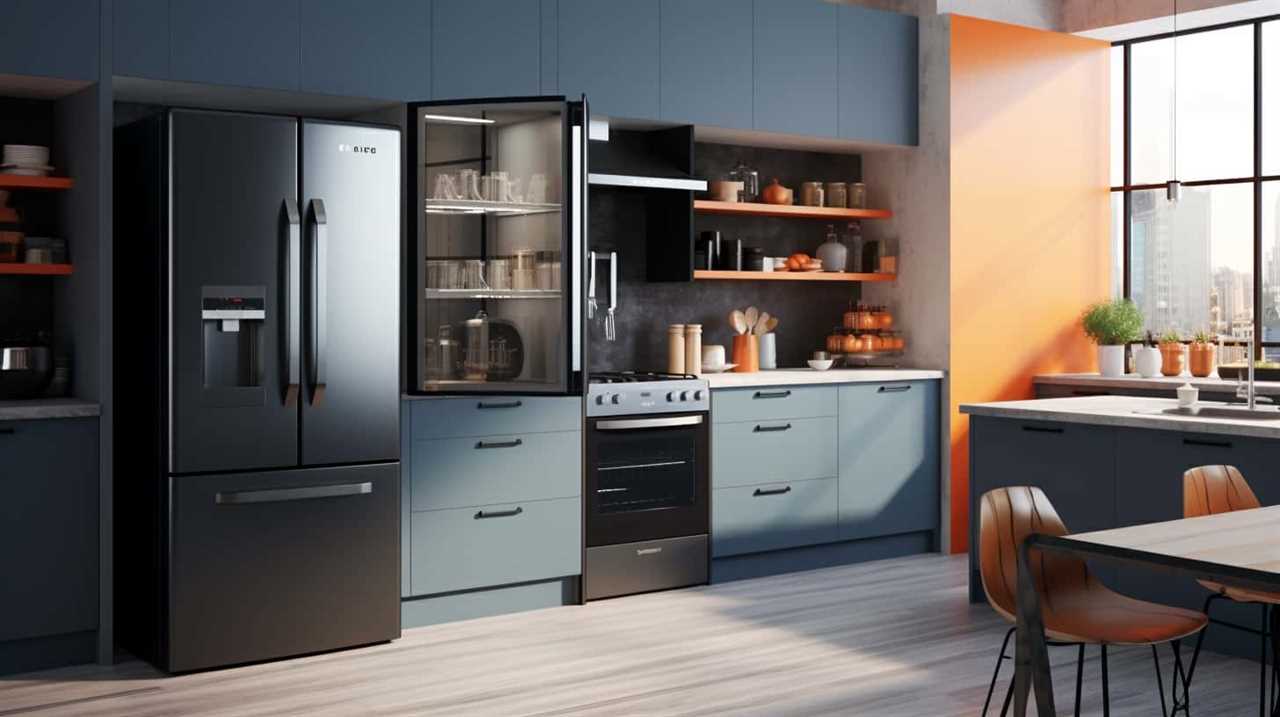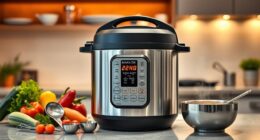To remove thick grease from kitchen cabinets like a pro, start by gathering the right supplies: a heavy-duty degreaser, dish soap, and baking soda. Spray the degreaser on the greasy areas, let it sit for about a minute, and then wipe with a soft cloth. For stubborn stains, mix baking soda with water to create a paste and scrub gently. Don't forget to rinse thoroughly to avoid residue. Incorporating regular maintenance, like bi-weekly wipe-downs, can help prevent future buildup. Want to make your cleaning routine even more effective? There's plenty more to contemplate!
Key Takeaways
- Use a heavy-duty degreaser or a DIY solution of warm water and dish soap for effective grease removal on cabinet exteriors.
- For stubborn stains, apply a baking soda paste and let it sit before scrubbing with an old toothbrush.
- Empty cabinets for deep cleaning and use a 50/50 vinegar-water solution on food contact surfaces.
- Rinse thoroughly after cleaning to remove residue, then dry cabinets completely to prevent moisture damage.
- Establish a bi-weekly cleaning schedule to maintain cabinet cleanliness and prevent grease buildup.
Understanding Kitchen Grease Buildup
In the heart of your kitchen, grease buildup is a common issue that arises from everyday cooking activities. As you cook, steam and food splatters create a sticky residue on cabinet surfaces, especially near stovetops and ovens.
This accumulation of kitchen grease, if left unattended, can lead to a thick, greasy layer that not only affects the appearance of your cabinets but also attracts more dirt.
Regular cleaning is essential to prevent grease from hardening over time, which can make grease removal increasingly difficult and potentially damage your cabinet finish.
The type of finish on your cabinets plays a significant role in how grease interacts with the surfaces. Glossy finishes may repel some grease, while matte finishes are more likely to absorb stains and become grimy.
Understanding the source and nature of the grease can help you choose the most effective cleaning methods tailored to the specific buildup you face.
Essential Cleaning Supplies
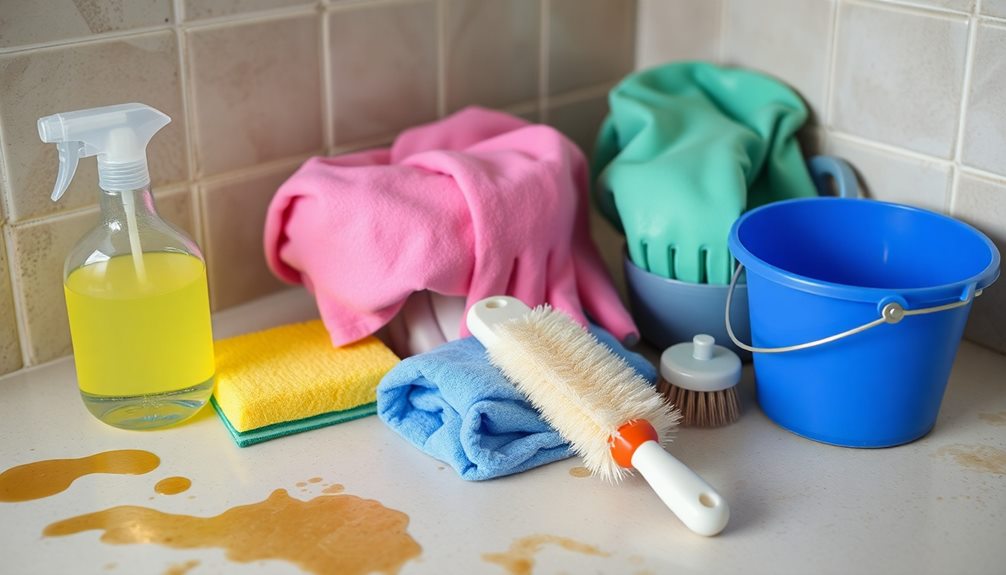
Having the right cleaning supplies is crucial for effectively removing grease from your kitchen cabinets. Each product plays a significant role in tackling thick grease without damaging your cabinets. Here's a list of the key supplies you'll need:
| Cleaning Supply | Purpose | Notes |
|---|---|---|
| Heavy-duty degreaser | Breaks down tough grease | Look for options like Ecolab Citrus Degreaser |
| Dish soap | Cuts through grease with surfactants | Great for regular maintenance |
| Vinegar | Natural acid that cleans and deodorizes | Combine with baking soda for tough stains |
| Baking soda | Provides gentle abrasion for stubborn stains | Safe for food-contact areas |
| Soft cloth or sponge | Wipes away grease without scratching | Always choose non-scratch varieties |
| Microfiber cloths | Final wipe-down to avoid streaks | Traps dust and grease, leaving surfaces clean |
Cleaning Cabinet Exteriors

Maintaining a clean and inviting kitchen relies heavily on the care you give to your cabinet exteriors. To effectively remove thick grease, start by choosing a suitable cleaning method. You can use a heavy-duty degreaser like Ecolab Heavy-Duty Citrus Degreaser. Simply spray it directly onto the surfaces and let it sit for one minute before wiping it clean.
If you prefer a DIY solution, mix warm water with dish soap and apply it with a non-scrubby sponge to cut through grease without damaging the cabinet finish.
For stubborn stains, an old toothbrush can help after you apply a degreaser, allowing for targeted scrubbing to lift the grease.
After using any cleaning solution, always follow up with rinsing off soap residue using a clean damp cloth. Make sure to dry the cabinets thoroughly to prevent moisture damage and streaking.
Deep Cleaning Cabinet Interiors

Deep cleaning your cabinet interiors is essential for keeping your kitchen organized and free from hidden grime. Start by emptying the cabinets to access all surfaces. Use a 50/50 vinegar-water solution to cut through grime and clean food contact surfaces safely. For stubborn stains, apply a paste of baking soda and water, letting it sit before scrubbing with a soft cloth or sponge.
| Step | Action | Purpose |
|---|---|---|
| 1 | Empty cabinets | Access all surfaces |
| 2 | Apply vinegar-water solution | Cut through grime |
| 3 | Use heavy-duty degreaser | Tackle stubborn stains |
For particularly resistant stains, an old toothbrush works wonders when paired with the heavy-duty degreaser. After scrubbing, rinse surfaces thoroughly with a clean damp cloth. Be sure to dry everything completely to prevent moisture damage and maintain the integrity of your cabinet materials. By following these steps, you'll guarantee your cabinet interiors are as clean and fresh as your kitchen deserves.
Strategies for Stubborn Stains

When it comes to tackling stubborn stains on kitchen cabinets, a strategic approach can make all the difference.
You'll want to choose the right cleaning solution and tools to guarantee you effectively remove grease without damaging your cabinet finish.
Here are three effective strategies:
- Heavy-duty degreaser: Apply a heavy-duty degreaser like Ecolab Heavy-Duty Citrus Degreaser directly to the stained area. Let it sit for one minute before wiping it clean with a soft cloth.
- Baking soda paste: Create a baking soda paste by mixing baking soda with water. Apply this paste to the stains and let it sit for at least 15 minutes to break down the grease.
- Vinegar solution: Mix vinegar with water in a 50/50 ratio for a general cleaner. Use it for hidden stains but remember to test it on an inconspicuous area first to avoid damaging your cabinet finish.
After applying any cleaning solution, use an old toothbrush to scrub gently at stubborn stains.
This combination of methods will help restore your cabinets to their former glory!
Evaluating Cleaning Methods
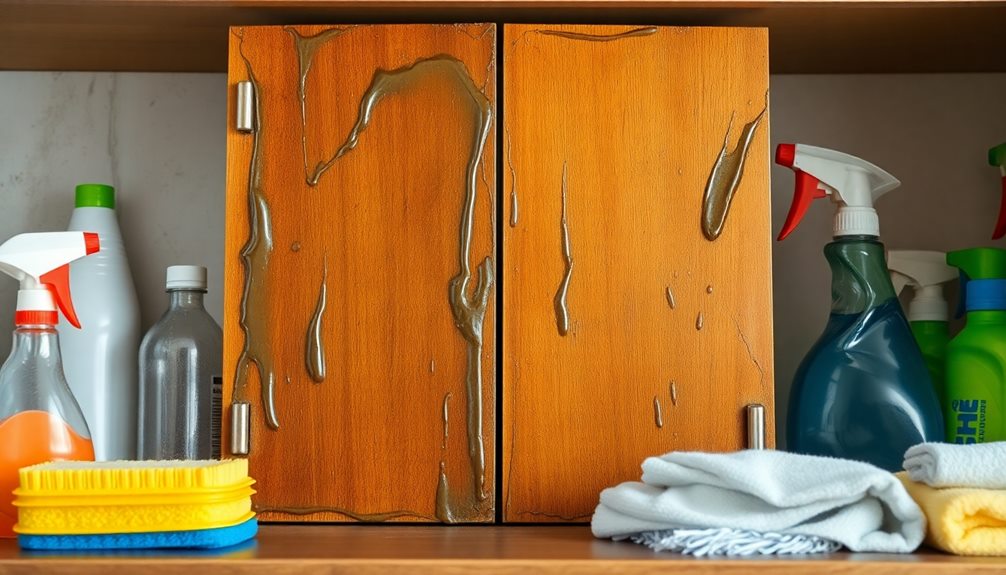
As you evaluate cleaning methods for removing grease from your kitchen cabinets, it's essential to contemplate both effectiveness and ease of use.
The Dawn Dish Soap Method stands out with a high rating of 4.5 / 5. It excels in grease removal and only takes 2 minutes per cabinet, making it a top choice.
The Pledge Everyday Cleaner Method also performs well, scoring 4 / 5 and offering a gentle citrus scent while maintaining a quick cleaning time of just 2 minutes.
If you're looking for a more traditional approach, the Murphy Oil Soap Method achieves a respectable 3 / 5 rating but requires 2.5 minutes for effective grease removal.
On the other hand, the Vinegar Soak Method scores low at 2 / 5, with an inefficient 18 minutes of cleaning time that yields minimal grease removal.
Safety and Environmental Considerations

Choosing cleaning products wisely can greatly impact both your health and the environment. By opting for non-toxic and eco-friendly solutions, you can minimize harmful chemical exposure and protect your kitchen cabinets. Here are three key considerations:
- Ingredient Labels: Always read the ingredient labels on commercial cleaners. Avoid harsh chemicals that can harm your health and the finish of your cabinets.
- Biodegradable Products: Choose biodegradable cleaning supplies like vinegar and baking soda, which break down naturally and reduce water pollution, especially in areas that drain into the environment.
- Ventilation: Guarantee proper ventilation while cleaning. This helps reduce inhalation of fumes from commercial products, which can contribute to indoor air pollution.
Consider using essential oils and plant-based cleaners for effective cleaning without synthetic additives.
These eco-friendly options not only clean well but also support a healthier home environment. By making these conscious choices, you protect both your well-being and the planet, creating a safer space for you and your family.
Creating a Cleaning Schedule

To keep your kitchen cabinets grease-free, it's essential to establish a consistent cleaning schedule.
Regular maintenance not only enhances the appearance of your cabinets but also contributes to a more organized kitchen environment, allowing you to maximize space and organization.
Aim to wipe down the cabinets every two weeks and plan for a thorough deep clean every few months.
Establishing Frequency Guidelines
Creating a cleaning schedule for your kitchen cabinets is crucial for maintaining their appearance and functionality.
To keep grease and stains at bay, follow these frequency guidelines:
- Bi-weekly Wipe-downs: Clean your kitchen cabinets every other week, especially near the stovetop and oven. Quick wipe-downs after cooking can prevent thick grease buildup.
- Quarterly Deep Cleaning: Every three months, empty out your cabinets and thoroughly clean them. This deep cleaning helps you tackle hidden stains and guarantees your cabinets look pristine.
- Regular Maintenance Checks: Incorporate brief maintenance sessions between deep cleans. This keeps your kitchen organized and allows for early identification of any stains or grease spots.
Organizing Cleaning Sessions
Organizing your cleaning sessions can streamline the process and make it less intimidating. Start by creating a cleaning schedule for your kitchen cabinets that includes quarterly deep-cleaning sessions. This approach helps you identify stains and prevents grease buildup.
To manage your workload effectively, stagger your cleaning sessions by sections. Focus on one area at a time, so you don't feel overwhelmed. For instance, you might consider how celebrity events, like Paula Deen's Wedding Highlights, often feature meticulous organization and attention to detail, which can inspire your cleaning routine.
Incorporate quick wipe-downs every other week to maintain cleanliness and tackle minor grease accumulation before it becomes a stubborn problem. Setting reminders or using a calendar can help you track your cleaning schedule, ensuring consistency and preventing neglect of cabinet maintenance.
Consider aligning your seasonal deep-cleaning sessions with other home maintenance tasks. This integration makes it easier to incorporate cabinet cleaning into your overall routine.
By maintaining this structured approach, you'll not only keep your kitchen cabinets spotless but also foster a habit of regular upkeep. Remember, consistency is key to preventing grease buildup and keeping your kitchen looking its best.
With these strategies, you'll feel more in control of your cleaning tasks and enjoy a cleaner, more organized kitchen.
Tips for Long-Term Maintenance

While maintaining your kitchen cabinets might seem like a chore, regular upkeep can considerably extend their lifespan and appearance. A clean kitchen environment not only enhances the aesthetic appeal but also supports a healthier lifestyle by promoting cleanliness and hygiene.
Here are some essential tips for long-term maintenance:
- Regularly clean your cabinets every other week using a mixture of warm water and dish soap. This simple routine helps prevent grease buildup and keeps them looking fresh. Consider incorporating health and wellness benefits into your cleaning habits to further enhance your living space.
- Declutter and empty cabinets quarterly to check for hidden stains and enhance organization. A clean, organized space not only looks better but also makes cleaning easier.
- Store cleaning supplies, like microfiber cloths and citrus-based cleaners, within easy reach. This encourages consistent maintenance and allows you to address spills promptly.
Consider applying a protective coating designed for kitchen cabinets to resist stains and make future cleaning a breeze.
By staying proactive and following these steps, you'll maintain a beautiful kitchen that stands the test of time. Keeping your cabinets clean and organized not only enhances their appearance but also promotes a hygienic cooking environment.
Make these practices a part of your routine, and enjoy the lasting benefits!
Frequently Asked Questions
How Do You Get Heavy Grease off Kitchen Cabinets?
To get heavy grease off kitchen cabinets, use a heavy-duty degreaser, letting it sit briefly before wiping. For stubborn spots, try a baking soda paste, scrub gently, and rinse thoroughly for best results.
What Is the Best Homemade Degreaser for Cabinets?
You'll whip up a magical potion that cuts through grease like a hot knife through butter! Mix equal parts vinegar and water, add some dish soap, and watch stubborn grime vanish before your eyes.
How Do You Remove Old Hardened Grease?
To remove old hardened grease, apply a heavy-duty degreaser and let it sit briefly. For stubborn spots, use a baking soda paste, scrub gently, and finish with warm soapy water to guarantee a clean surface.
Why Are My Kitchen Cabinets Sticky After Cleaning?
Ah, the quandary of sticky kitchen cabinets! If they're feeling tacky after cleaning, it's likely due to leftover cleaner residue. Make sure you've rinsed thoroughly, or you might find that grease sticking around longer than desired.
Conclusion
By understanding grease buildup, using the right supplies, and applying effective techniques, you can restore your kitchen cabinets to their former glory. Embrace regular cleaning, tackle stubborn stains, and evaluate your methods to find what works best for you. Remember, safety and environmental considerations matter, so choose eco-friendly products. With a consistent cleaning schedule and proactive maintenance, you'll keep your cabinets looking great, lasting longer, and making your kitchen a space you love to cook in.
